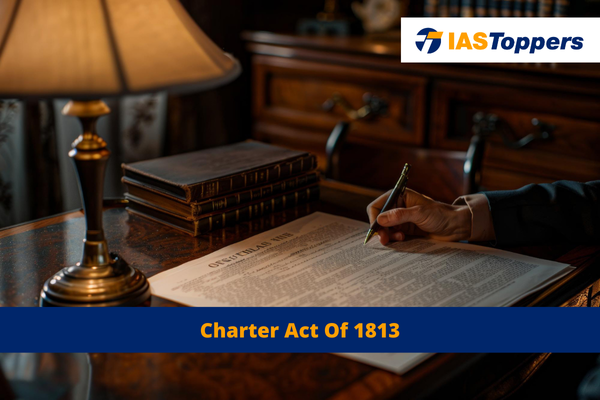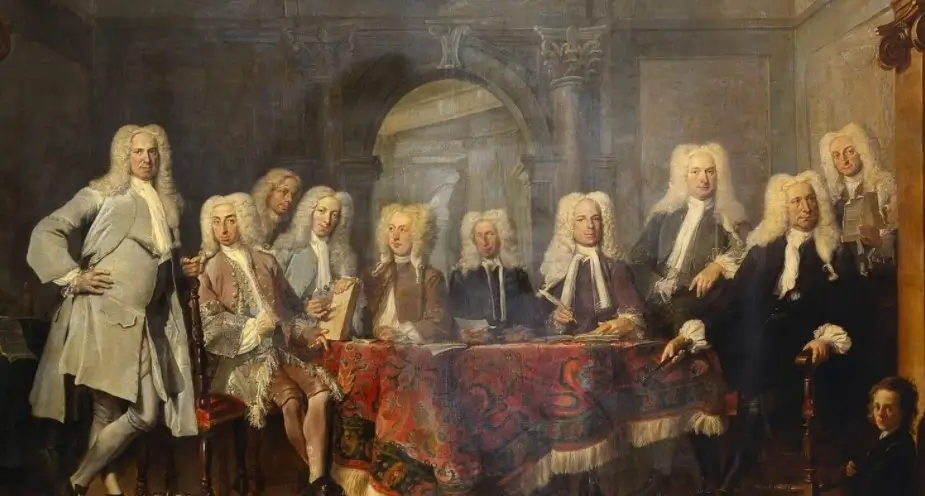Charter Act of 1813 was a pivotal legislation enacted by the British Parliament to curtail the East India Company’s trade monopoly in India. Introducing reforms in governance, education, and religion, the Charter Act of 1813 simultaneously fostered British economic expansion. In this article, you will know all about Charter Act Of 1813 including its background and key features. It is very important topic for GS Paper-1 Indian History of UPSC IAS Exam.
Table of Content
- Overview of Charter Act Of 1813
- Background of Charter Act Of 1813
- Key features of the Charter Act 1813
- Conclusion
Overview of Charter Act Of 1813
| Aspect | Details |
| Introduced by | British Parliament |
| Objective | Terminate the East India Company’s trade monopoly in India, while preserving its monopoly on trade with China and tea trade in India |
| Alternative Name | East India Company Act, 1813 |
| Governor-General | Lord Hastings |
| Applicable Territory | British-controlled territories in India |
| Main Provisions | Extension of the Company’s rule, establishment of further regulations for governance, better administration of justice, and regulation of trade |
| Royal Assent | 21 July 1813 |
| Repealed by | Government of India Act, 1915 |
Background of Charter Act Of 1813
- Before the Charter Act 1813, the East India Company enjoyed a monopoly over trade in India.
- This allowed them to amass significant profits and exercise control over Indian territories.
- However, in response to the closure of European ports for Britain due to Napoleon’s actions, commercial stakeholders in England advocated for the termination of the Company’s exclusive trading rights in India. The Act of 1813 aimed to address these concerns.
- The primary objective of the Charter Act 1813 was to break the East India Company’s monopoly on trade in India, with the exception of the trade in tea, opium, and with China.
- This allowed British merchants to trade in India under a strict licensing system, expanding British influence and facilitating the growth of British dominance in India.
Key features of the Charter Act 1813
The Charter Act 1813 introduced several significant provisions that redefined the political and economic landscape of British India.
Some of the main features of the Charter Act 1813 include:
- End of the East India Company’s Monopoly: The Act terminated the East India Company’s monopoly on trade in India. However, the Company retained its monopoly on trade with China and the trade in tea and opium.
- Extension of the Company’s Rule: The Act extended the East India Company’s rule (possession of territories and the revenue) in India for another 20 years.
- Promotion of Christianity: The Act granted permission for Christian missionaries to come to India to promote moral improvements and religious proselytization.
- Empowerment of Local Governments: The Act allowed local governments, such as panchayats and municipalities, to levy taxes on their subjects, subject to the jurisdiction of the Supreme Court.
- Education Funding: The clause 43 of charter act 1813 allocated INR 100,000 per year for the promotion of Indian education, contributing to the growth of Indian literature and scientific knowledge among students.
- Dividend: Shareholders of the East India Company were given a 10.5 % dividend on the revenue of India.
- Widening the Board of Control’s Influence: The Board of Control’s authority experienced a significant expansion.
- Establishing British Territorial Constitutional Status: Rules established by the Madras, Bombay, and Calcutta Councils needed presentation before the British Parliament, marking the first clear determination of the British territories’ constitutional status in India.
- Enhanced Oversight and Delineation of Finances: Distinct records for business dealings and territorial income were mandated, with the Board of Control’s supervisory and guiding power not only clarified but also notably broadened.
Conclusion
The company Charter Act of 1813 played a pivotal role in reshaping British India’s political and economic landscape. By terminating the East India Company’s trade monopoly in India, the Act opened doors for British merchants and expanded British influence in the region. Additionally, the Act addressed various aspects of governance, such as the extension of the Company’s rule, promotion of Christianity, empowerment of local governments, and allocation of funds for education. Although the Charter Act of 1813 has been repealed, its provisions and impact on India’s history are noteworthy and serve as a reminder of the complex relationship between Britain and India during the colonial era.
Ref:Source-1
| Other Articles in History & Culture | |
| The Indian Councils Act 1861 | Government of India Act 1919 |
| Vernacular Press Act 1878 | Subsidiary Alliance System |
| Poona Pact (1932) | Ryotwari System |
FAQs(Frequently Asked Questions)
What is the charter act of 1813?
The Charter Act of 1813 was a significant legislation passed by the British Parliament, aiming to end the East India Company’s trade monopoly in India while preserving its monopoly with China and India’s tea trade.
What is the significance and importance of charter act 1813?
The Charter Act of 1813 holds great importance as it marked the end of East India Company’s trading monopoly in India, propelled British economic growth, and introduced key governance, education, and religious reforms.
What did the charter act of 1813 provide?
The Charter Act of 1813 abolished East India Company’s trading monopoly, except for tea and China trades. It also extended the Company’s rule, promoted Christianity, empowered local governments, and allocated funds for Indian education.
Who was the governor general when the Charter Act of 1813 was passed?
Lord Hastings was the Governor General of India when the Charter Act of 1813 was passed.
What was the impact of 1813 Charter Act on Indian education?
The 1813 Charter Act, often referred to as the financial current, played a crucial role in reviving Indian literary traditions and promoting scientific progress. Furthermore, it increased the scope and accountability of the Corporation in managing India’s educational system, reinforcing their stewardship.
How did the Charter act of 1813 affect Indian craftsmen?
The 1813 Charter Act curtailed the East India Company’s trade monopoly, apart from tea and China dealings, leading to a flood of British merchandise in India. This challenged Indian handicrafts, forcing them to undersell and compete with machine-made products. Furthermore, a declining patronage since the 18th century and India’s raw material supplier role post-Industrial Revolution worsened artisans’ situation.



